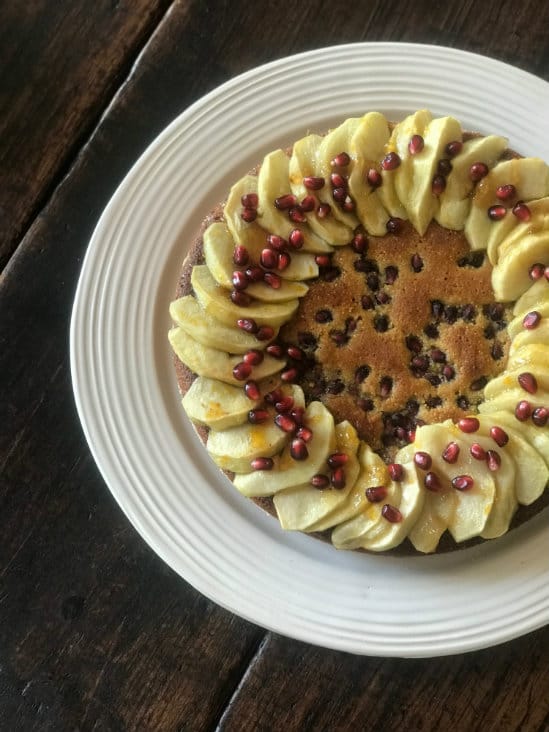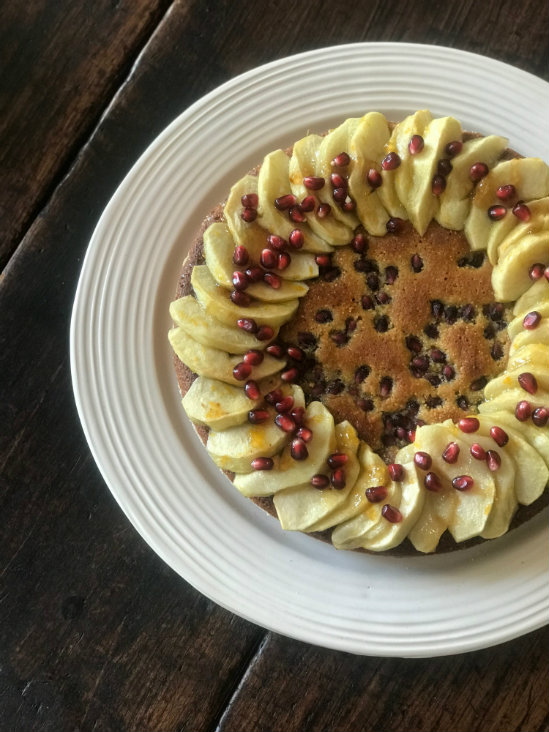Recipe: Pomegranate Cake
It's traditional to consume pomegranates on Rosh Hashanah.

It's traditional to consume pomegranates on Rosh Hashanah.

Fall is so full of apples and mythology! Bear with me a moment and I will explain the epic convergence that is possible in a slice of cake.
Demeter, the corn goddess, had a daughter named Persephone who, as you may have heard, committed the giant boo-boo no-no of eating a little bit of pomegranate on an unintentional field trip to Hell, the pomegranate being a symbol of the indissolubility of the bonds of marriage, as Persephone would have known if she'd been paying any attention at all. According to this narrative, we have Persephone’s inability to resist the little jewel-like arils to thank for the existence of winter, the annual pause in earth’s fertility that keeps us chilled and hungry for salad while Persephone makes her conjugal visit to Hades.
For the Zoroastrians, the evergreen pomegranate is a symbol of the immortality of the soul and its consumption a pathway to invincibility. Ayurvedically, the fruit is a restorative associated with self-sufficiency, creativity, and clarity of perception.
Along with the olive, date and fig, the pomegranate is one of the four holy trees of Islam.
And in most branches of Judaism, it’s traditional to consume pomegranates on the upcoming holiday of Rosh Hashanah because the fruit is said to have 613 seeds, which corresponds with the 613 commandments of the Torah. The pomegranate in Judaism is further associated with good deeds, abundance and, in a fun twist, fertility (just not of the salad crops variety).
In the spirit of the giant global task of compassion, interconnection and mutual appreciation across all beliefs, you could look at this cake as a symbol of any number of things.
On a plate, it represents a dessert free of dairy and gluten, sure to warm the heart of any host seeking to bring a multitude to the table.
Ingredients
2-3 tart apples (I like a northern spy), peeled and sliced into ¼” wedges
1 tablespoon fresh Meyer lemon juice
3 tablespoons honey
Zest of one Meyer lemon, finely grated
2 teaspoons cornstarch
2 tablespoons extra virgin olive oil
½ teaspoon Maldon or other flaky salt
4 eggs
½ cup honey
1 tablespoon fresh Meyer lemon juice
¼ cup extra-virgin olive oil
½ teaspoon vanilla extract
2 cups almond flour or almond meal, lightly packed (180 g)
½ cup coarse cornmeal or polenta
1 teaspoon baking powder
½ teaspoon baking soda
½ teaspoon ground cardamom
½ teaspoon fine-grain sea salt
⅔ cup pomegranate arils, divided
To serve (to the dairy-friendly only, of course):
4 ounces crème fraiche or full-fat Greek yogurt, whisked to soft peaks with ½ cup heavy cream and ½ teaspoon vanilla bean paste or vanilla extract
Directions
Place a rack in the center of the oven and preheat the oven to 400°.
Line a baking sheet with parchment paper. In a medium bowl, toss the apples with lemon juice, honey, zest, cornstarch and olive oil. Transfer to the baking sheet, reserving the bowl for the next step. Bake for 15 to 25 minutes, until golden and bubbly. Sprinkle with the salt and set aside.
Reduce oven temperature to 325°. Lightly oil the sides of a 9-inch round cake pan and dust with almond meal. Line the bottom with a circle of parchment.
In the mixing bowl you used for the apples, whisk together the eggs, honey, lemon juice, olive oil and vanilla until well combined.
In a small bowl, combine the almond meal, cornmeal, baking powder, baking soda and salt.
Pour the wet ingredients into the dry and fold to combine. Pour the mixture into the prepared pan, and drop the arils on the surface, reserving a few tablespoons for garnish.
Bake for 35 to 40 minutes, until the cake is golden brown and the center is firm to the touch. Place the cake on a wire rack to cool slightly, then invert, remove the parchment and set the cake arils-up on a serving plate. Arrange the reserved apple slices on top of the cake, including any of the caramelized juices; the residual heat of the cake should melt them in nicely. Scatter the remaining arils on top of this.

